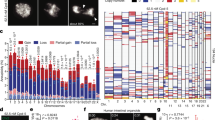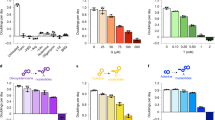Abstract
JACOB, BRENNER AND CUZIN1 suggested that prokaryote nuclear segregation was achieved by cell surface extension between surface sites to which the chromosome is permanently attached (Fig. 1a). Their model (model A) showed nuclear segregation occurring in newly divided cells, with all surface extension in one cycle occurring between the nuclei. Thus at cell division, nuclei would be arranged symmetrically in the half cell but asymmetrically during the interdivisional period. If nuclear segregation occurs during mid-cycle and cell extension is continuous throughout the cycle, the nucleus cannot reach a symmetrical position (that is at 25% of the cell length) by the end of the cycle relying solely on length extension. To overcome these difficulties, Clark2 proposed that the nucleus is always located at the junction of old and new membranes with growth occurring on one side of the nucleus (model B, Fig. 1b). At nuclear segregation, the growing point divides allowing growth of the cell envelope between the nuclei as shown in Fig. 1b. Nuclei remain attached at the site of envelope extension, giving a newborn cell with an asymmetrically arranged nucleus. Donachie and Begg3 have presented evidence for terminal growth regions in slow growing cells as predicted by Clark's model. A third possibility is that the nucleus is located centrally in new born cells and moves to a position at the centre of a half cell at the time of segregation (model C, Fig. 1c). These, and other possibilities, can be explored by determining the position of nuclei in relation to cell length in exponential phase cells.
This is a preview of subscription content, access via your institution
Access options
Subscribe to this journal
Receive 51 print issues and online access
$199.00 per year
only $3.90 per issue
Buy this article
- Purchase on SpringerLink
- Instant access to full article PDF
Prices may be subject to local taxes which are calculated during checkout
Similar content being viewed by others
References
Jacob, F., Brenner, S., and Cuzin, F., Cold Spring Harb. Symp. quant. Biol., 28, 329 (1963).
Clark, D. J., Cold Spring Harb. Symp. quant. Biol., 33, 823 (1969).
Donachie, W. D., and Begg, K. J., Nature, 227, 1220 (1970).
Sargent, M. G., J. Bact., 116, 736 (1973).
Paulton, R. J. L., J. Bact., 104, 762 (1970).
Mendelson, N. H., Cold Spring Harb. Symp. quant. Biol., 33, 313 (1969).
Cooper, S., and Helmstetter, C. E., J. molec. Biol., 31, 519 (1968).
Author information
Authors and Affiliations
Rights and permissions
About this article
Cite this article
SARGENT, M. Nuclear segregation in Bacillus subtilis. Nature 250, 252–254 (1974). https://doi.org/10.1038/250252a0
Received:
Revised:
Issue date:
DOI: https://doi.org/10.1038/250252a0



